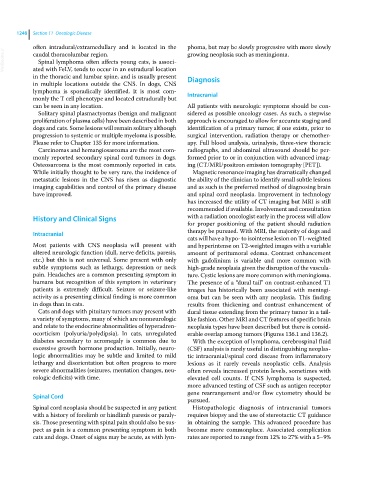Page 1310 - Clinical Small Animal Internal Medicine
P. 1310
1248 Section 11 Oncologic Disease
often intradural/extramedullary and is located in the phoma, but may be slowly progressive with more slowly
VetBooks.ir caudal thoracolumbar region. growing neoplasia such as meningioma.
Spinal lymphoma often affects young cats, is associ-
ated with FeLV, tends to occur in an extradural location
in the thoracic and lumbar spine, and is usually present Diagnosis
in multiple locations outside the CNS. In dogs, CNS
lymphoma is sporadically identified. It is most com- Intracranial
monly the T cell phenotype and located extradurally but
can be seen in any location. All patients with neurologic symptoms should be con-
Solitary spinal plasmactyomas (benign and malignant sidered as possible oncology cases. As such, a stepwise
proliferation of plasma cells) have been described in both approach is encouraged to allow for accurate staging and
dogs and cats. Some lesions will remain solitary although identification of a primary tumor, if one exists, prior to
progression to systemic or multiple myeloma is possible. surgical intervention, radiation therapy or chemother-
Please refer to Chapter 135 for more information. apy. Full blood analysis, urinalysis, three‐view thoracic
Carcinomas and hemangiosarcoma are the most com- radiographs, and abdominal ultrasound should be per-
monly reported secondary spinal cord tumors in dogs. formed prior to or in conjunction with advanced imag-
Osteosarcoma is the most commonly reported in cats. ing (CT/MRI/positron emission tomography [PET]).
While initially thought to be very rare, the incidence of Magnetic resonance imaging has dramatically changed
metastatic lesions in the CNS has risen as diagnostic the ability of the clinician to identify small subtle lesions
imaging capabilities and control of the primary disease and as such is the preferred method of diagnosing brain
have improved. and spinal cord neoplasia. Improvement in technology
has increased the utility of CT imaging but MRI is still
recommended if available. Involvement and consultation
History and Clinical Signs with a radiation oncologist early in the process will allow
for proper positioning of the patient should radiation
Intracranial therapy be pursued. With MRI, the majority of dogs and
cats will have a hypo‐ to isointense lesion on T1‐weighted
Most patients with CNS neoplasia will present with and hyperintense on T2‐weighted images with a variable
altered neurologic function (dull, nerve deficits, paresis, amount of peritumoral edema. Contrast enhancement
etc.) but this is not universal. Some present with only with gadolinium is variable and more common with
subtle symptoms such as lethargy, depression or neck high‐grade neoplasia given the disruption of the vascula-
pain. Headaches are a common presenting symptom in ture. Cystic lesions are more common with meningioma.
humans but recognition of this symptom in veterinary The presence of a “dural tail” on contrast‐enhanced T1
patients is extremely difficult. Seizure or seizure‐like images has historically been associated with meningi-
activity as a presenting clinical finding is more common oma but can be seen with any neoplasia. This finding
in dogs than in cats. results from thickening and contrast enhancement of
Cats and dogs with pituitary tumors may present with dural tissue extending from the primary tumor in a tail‐
a variety of symptoms, many of which are nonneurologic like fashion. Other MRI and CT features of specific brain
and relate to the endocrine abnormalities of hyperadren- neoplasia types have been described but there is consid-
ocorticism (polyuria/polydipsia). In cats, unregulated erable overlap among tumors (Figures 136.1 and 136.2).
diabetes secondary to acromegaly is common due to With the exception of lymphoma, cerebrospinal fluid
excessive growth hormone production. Initially, neuro- (CSF) analysis is rarely useful in distinguishing neoplas-
logic abnormalities may be subtle and limited to mild tic intracranial/spinal cord disease from inflammatory
lethargy and disorientation but often progress to more lesions as it rarely reveals neoplastic cells. Analysis
severe abnormalities (seizures, mentation changes, neu- often reveals increased protein levels, sometimes with
rologic deficits) with time. elevated cell counts. If CNS lymphoma is suspected,
more advanced testing of CSF such as antigen receptor
gene rearrangement and/or flow cytometry should be
Spinal Cord
pursued.
Spinal cord neoplasia should be suspected in any patient Histopathologic diagnosis of intracranial tumors
with a history of forelimb or hindlimb paresis or paraly- requires biopsy and the use of stereotactic CT guidance
sis. Those presenting with spinal pain should also be sus- in obtaining the sample. This advanced procedure has
pect as pain is a common presenting symptom in both become more commonplace. Associated complication
cats and dogs. Onset of signs may be acute, as with lym- rates are reported to range from 12% to 27% with a 5–9%

